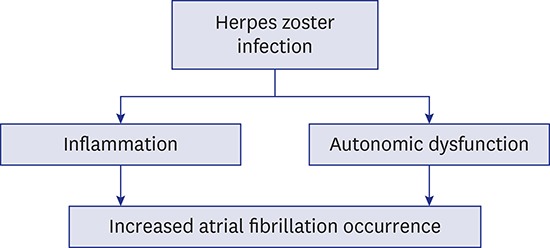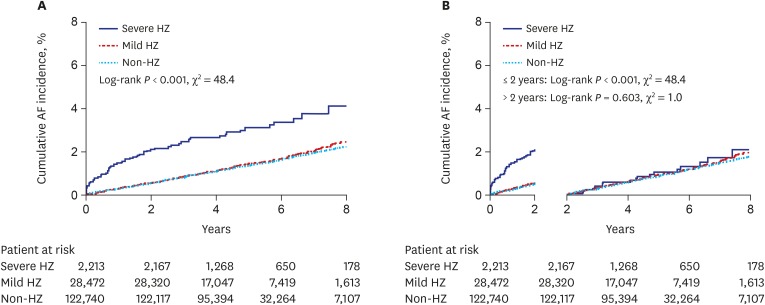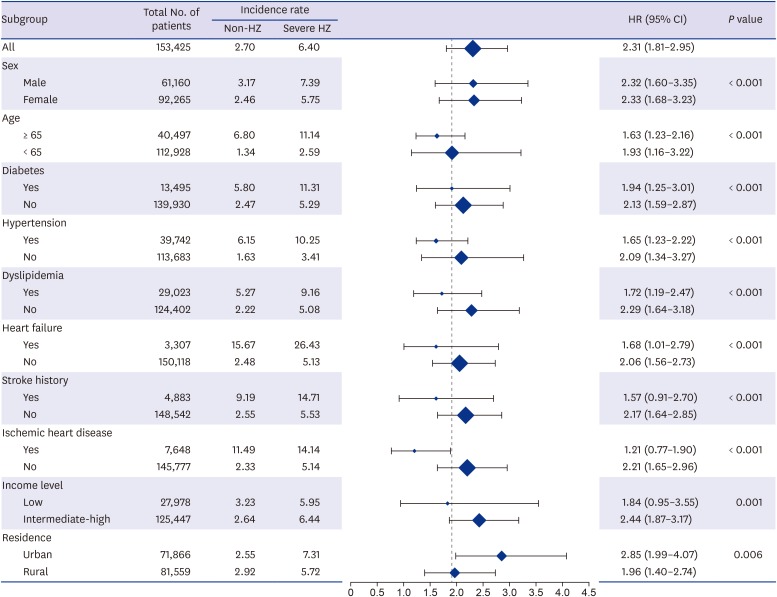1. Shin HW, Kim YN, Bae HJ, Lee HM, Cho HO, Cho YK, et al. Trends in oral anticoagulation therapy among Korean patients with atrial fibrillation: the KORean Atrial Fibrillation Investigation. Korean Circ J. 2012; 42(2):113–117. PMID:
22396699.
2. Jung BC, Kim NH, Nam GB, Park HW, On YK, Lee YS, et al. The Korean Heart Rhythm Society's 2014 statement on antithrombotic therapy for patients with nonvalvular atrial fibrillation: Korean Heart Rhythm Society. Korean Circ J. 2015; 45(1):9–19. PMID:
25653698.
3. Guo Y, Lip GY, Apostolakis S. Inflammation in atrial fibrillation. J Am Coll Cardiol. 2012; 60(22):2263–2270. PMID:
23194937.
4. Chen PS, Chen LS, Fishbein MC, Lin SF, Nattel S. Role of the autonomic nervous system in atrial fibrillation: pathophysiology and therapy. Circ Res. 2014; 114(9):1500–1515. PMID:
24763467.
5. Ren Y, Zeng RX, Li JJ, Guo LH, He DY, Li Y, et al. Relation of C-reactive protein and new-onset atrial fibrillation in patients with acute myocardial infarction: a systematic review and meta-analysis. Int J Cardiol. 2015; 190:268–270. PMID:
25932802.
6. Schauerte P, Scherlag BJ, Patterson E, Scherlag MA, Matsudaria K, Nakagawa H, et al. Focal atrial fibrillation: experimental evidence for a pathophysiologic role of the autonomic nervous system. J Cardiovasc Electrophysiol. 2001; 12(5):592–599. PMID:
11386522.
7. Rimland D, Moanna A. Increasing incidence of herpes zoster among Veterans. Clin Infect Dis. 2010; 50(7):1000–1005. PMID:
20178416.
8. Kawai K, Gebremeskel BG, Acosta CJ. Systematic review of incidence and complications of herpes zoster: towards a global perspective. BMJ Open. 2014; 4(6):e004833.
9. Cohen JI. Herpes zoster. N Engl J Med. 2013; 369(18):1766–1767.
10. Weaver SM, Kelly AP. Herpes zoster as a cause of neurogenic bladder. Cutis. 1982; 29(6):611–612. PMID:
7105835.
11. Lambert SB. Postherpetic neuralgia after herpes zoster vaccination. JAMA. 2012; 308(14):1427. PMID:
23047346.
12. McCrary ML, Severson J, Tyring SK. Varicella zoster virus. J Am Acad Dermatol. 1999; 41(1):1–14. PMID:
10411403.
13. Son MK, Lim NK, Cho MC, Park HY. Incidence and risk factors for atrial fibrillation in Korea: the National Health Insurance Service Database (2002–2010). Korean Circ J. 2016; 46(4):515–521. PMID:
27482260.
14. Kang SH, Choi EK, Han KD, Lee SR, Lim WH, Cha MJ, et al. Underweight is a risk factor for atrial fibrillation: a nationwide population-based study. Int J Cardiol. 2016; 215:449–456. PMID:
27131763.
15. Lee SR, Choi EK, Rhee TM, Lee HJ, Lim WH, Kang SH, et al. Evaluation of the association between diabetic retinopathy and the incidence of atrial fibrillation: a nationwide population-based study. Int J Cardiol. 2016; 223:953–957. PMID:
27589043.
16. Kim YJ, Lee CN, Lim CY, Jeon WS, Park YM. Population-based study of the epidemiology of herpes zoster in Korea. J Korean Med Sci. 2014; 29(12):1706–1710. PMID:
25469074.
17. Ommen SR, Odell JA, Stanton MS. Atrial arrhythmias after cardiothoracic surgery. N Engl J Med. 1997; 336(20):1429–1434. PMID:
9145681.
18. Jacob KA, Buijsrogge MP, Frencken JF, Ten Berg MJ, Suyker WJ, van Dijk D, et al. White blood cell count and new-onset atrial fibrillation after cardiac surgery. Int J Cardiol. 2016; 228:971–976. PMID:
27914360.
19. Boos CJ, Anderson RA, Lip GY. Is atrial fibrillation an inflammatory disorder? Eur Heart J. 2006; 27(2):136–149. PMID:
16278230.
20. Kaireviciute D, Blann AD, Balakrishnan B, Lane DA, Patel JV, Uzdavinys G, et al. Characterisation and validity of inflammatory biomarkers in the prediction of post-operative atrial fibrillation in coronary artery disease patients. Thromb Haemost. 2010; 104(1):122–127. PMID:
20458440.
21. Henningsen KM, Therkelsen SK, Bruunsgaard H, Krabbe KS, Pedersen BK, Svendsen JH. Prognostic impact of hs-CRP and IL-6 in patients with persistent atrial fibrillation treated with electrical cardioversion. Scand J Clin Lab Invest. 2009; 69(3):425–432. PMID:
19204850.
22. Chiang CH, Huang CC, Chan WL, Huang PH, Chen YC, Chen TJ, et al.
Herpes simplex virus infection and risk of atrial fibrillation: a nationwide study. Int J Cardiol. 2013; 164(2):201–204. PMID:
21782262.
23. Andrew P, Montenero AS. Is there a link between atrial fibrillation and certain bacterial infections? J Cardiovasc Med (Hagerstown). 2007; 8(12):990–996. PMID:
18163009.
24. Chen M, Yu L, Zhou X, Liu Q, Jiang H, Zhou S. Low-level vagus nerve stimulation: an important therapeutic option for atrial fibrillation treatment via modulating cardiac autonomic tone. Int J Cardiol. 2015; 199:437–438. PMID:
26263011.
25. Armour JA, Murphy DA, Yuan BX, Macdonald S, Hopkins DA. Gross and microscopic anatomy of the human intrinsic cardiac nervous system. Anat Rec. 1997; 247(2):289–298. PMID:
9026008.
26. Choi EK, Shen MJ, Han S, Kim D, Hwang S, Sayfo S, et al. Intrinsic cardiac nerve activity and paroxysmal atrial tachyarrhythmia in ambulatory dogs. Circulation. 2010; 121(24):2615–2623. PMID:
20529998.
27. Edelman DA, Antaki F, Basson MD, Salwen WA, Gruber SA, Losanoff JE. Ogilvie syndrome and herpes zoster: case report and review of the literature. J Emerg Med. 2010; 39(5):696–700. PMID:
19327938.
28. Kang JH, Park YS, Park SY, Kim SB, Ko KP, Seo YH. Varicella seroprevalence among health care workers in Korea: validity of self-reported history and cost-effectiveness of prevaccination screening. Am J Infect Control. 2014; 42(8):885–887. PMID:
25087140.






 PDF
PDF Citation
Citation Print
Print






 XML Download
XML Download